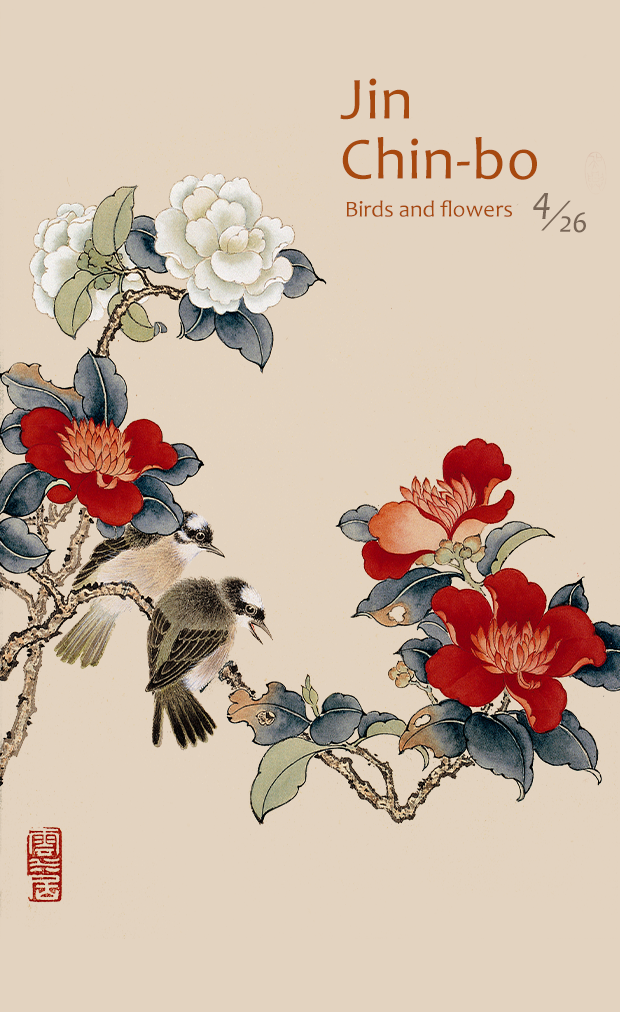

Jin Chin-bo (1910-1998), given name Kai-ye, professional name Ji-ou, was born on April 26, 1910, the second year of the Xuantong reign of the Qing Dynasty, in Nanxun Town, Wuxing (present day Huzhou City), Zhejiang Province. He came from a prosperous artistic family with an impressive art collection. His uncle and aunt, Jin Cheng and Jin Zhang, were both famous painters of the early Republican period, while the family boasted accomplished bamboo carvers in his uncles, Jin Shao-tang and Jin Shao-fang, and his cousin, Jin Kai-ying, who was also a pioneer in Taiwan's oil industry. The National Museum of History has carved bamboo armrests and fans from all three men in its collection.
Jin Chin-bo started studying painting with Jin Cheng from an early age. Jin Cheng — professionally named Bei-lou and Ou-hu — was a leading figure of the northern painting school in the early Republican period, as well as a co-founder of the Chinese Painting Research Academy and the Hushe Painting Society. Since he put forward Jin Chin-bo's name as a member of the society, Ji-ou came to be regarded as Ou-hu's successor Subsequently, Jin Chin-bo under the guidance of Jin Zhang and the Qing court painter Yu Ming began studying traditional bird-and-flower and figurative painting techniques from the Song, Yuan, Ming and Qing dynasties.
Jin Chin-bo also had access to the collections of the Gu Wu Chenlie Suo (Gallery of Ancient Relics) of the Palace Museum in Beijing and of the renowned collector Pang Yuanji, enabling him to make copies of famous masterpieces. This opportunity allowed Jin to cultivate a foundation in painting and to develop his own meticulous technique, working from wonderful examples across a range of genres, from bird-and-flower scenes, figures and landscapes, to the fine gongbi brushwork of the northern school and the more relaxed, unrestrained style of the southern school. His specialist background as a graduate of the Yenching University Institute of Biology gave him a keen eye when painting different species, enabling him to paint highly skilled depictions of flowers and birds with the meticulous scrutiny of a scientist. It was because of this that Jin Chin-bo became known as Taiwan's premier bird-and-flower painter.
Jin Chin-bo continued his practice after moving to Taiwan, holding many solo exhibitions and participating in national painting and calligraphy exhibitions as an artist and judge. His work is highly acclaimed in the art world and has had a major influence on the formation and development of Taiwanese contemporary ink painting. Jin Chin-bo has also taught at National Taiwan Normal University, Chinese Culture University and the National Taiwan College of Arts (now called the National Taiwan University of Arts), where he has nurtured many talented artists. As a teacher, he used his collection as teaching material to develop students' aesthetic tastes and to demonstrate masterful techniques by providing students with drafts from which to copy. Jin borrowed from both.
Chin-bo, Jin Chin-bo's style name, means “excellence through hard work” or “practice makes perfect,” reflecting a life devoted to artistic creation and art education. In June 2000, the National Museum of History held a retrospective of his work, entitled “Reflections from the Past, Forging Today — A Commemorative Exhibition of Jin Chin-bo” Preparation for the exhibition involved collating nearly 1,000 works, including landscapes, figures and flowers using both the gongbi fine brushwork technique and the mogu “boneless” technique. The paintings had to be categorized and photographed, while his major works were published under one title for viewers to enjoy and to serve as a reference for academic study.
His family also wished to donate some of the artist's representative works to the national collection, bequeathing more than 200 works to the National Museum of History. This donation brought the total number of his works held by the museum to 266, representing one of the biggest collections from a single artist in the museum's collection. The National Museum of History would therefore like to designate Jin Chin-bo's birthday as Jin Chin-bo Artist's Day to showcase his significance to the world of Taiwanese contemporary art and to commemorate how much he has given to the art world. We invite you to enjoy with us these selected works as an introduction to the world of Jin Chin-bo's exquisite bird-and-flower, landscape and figurative paintings.
